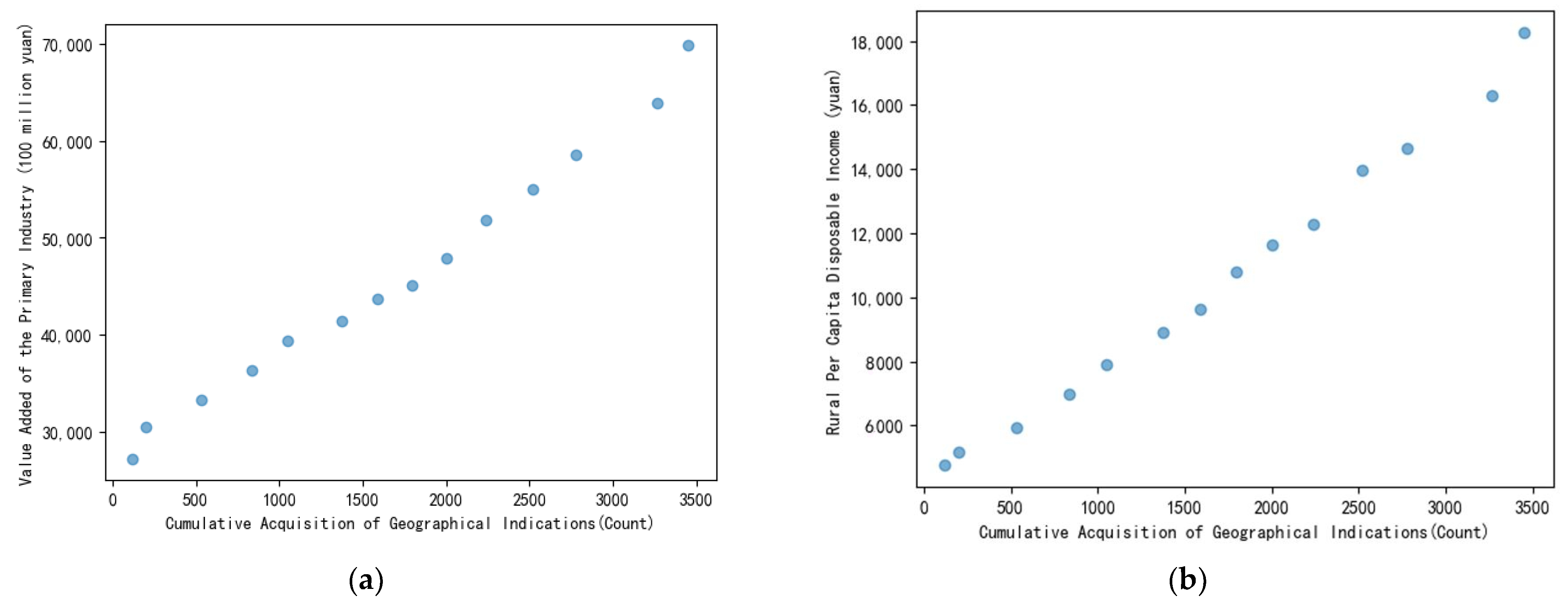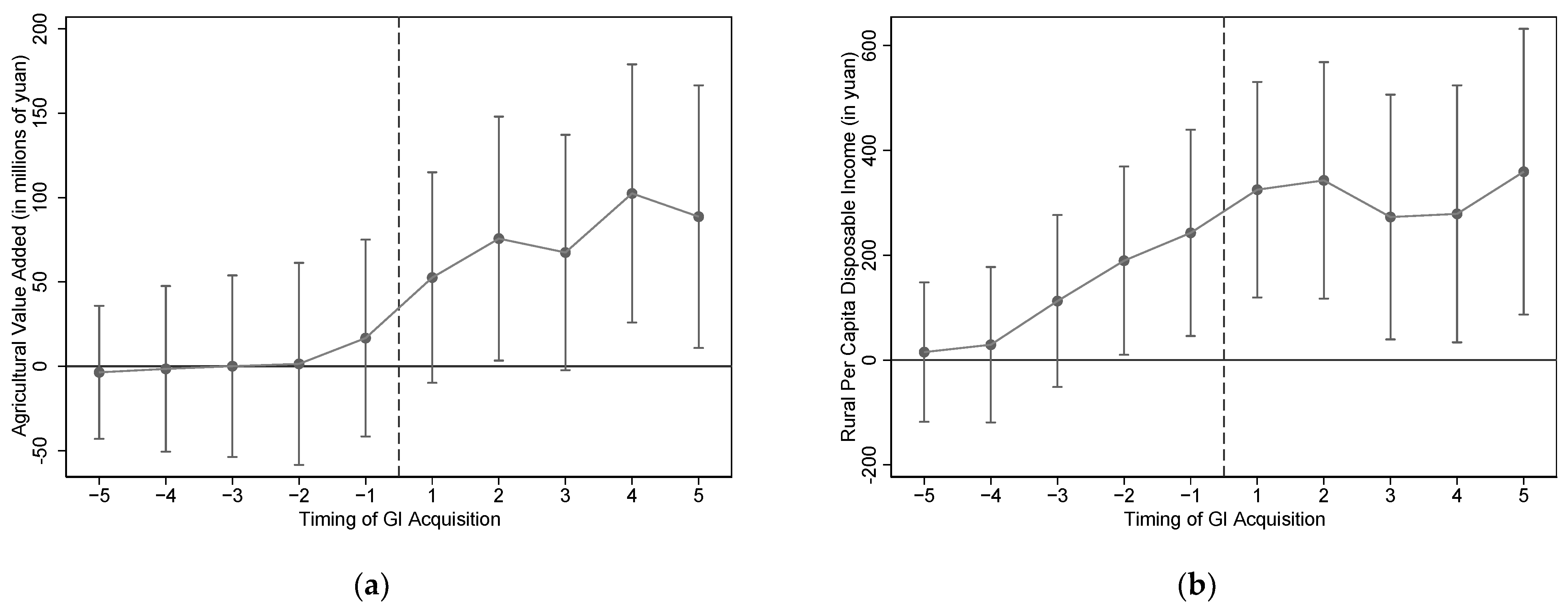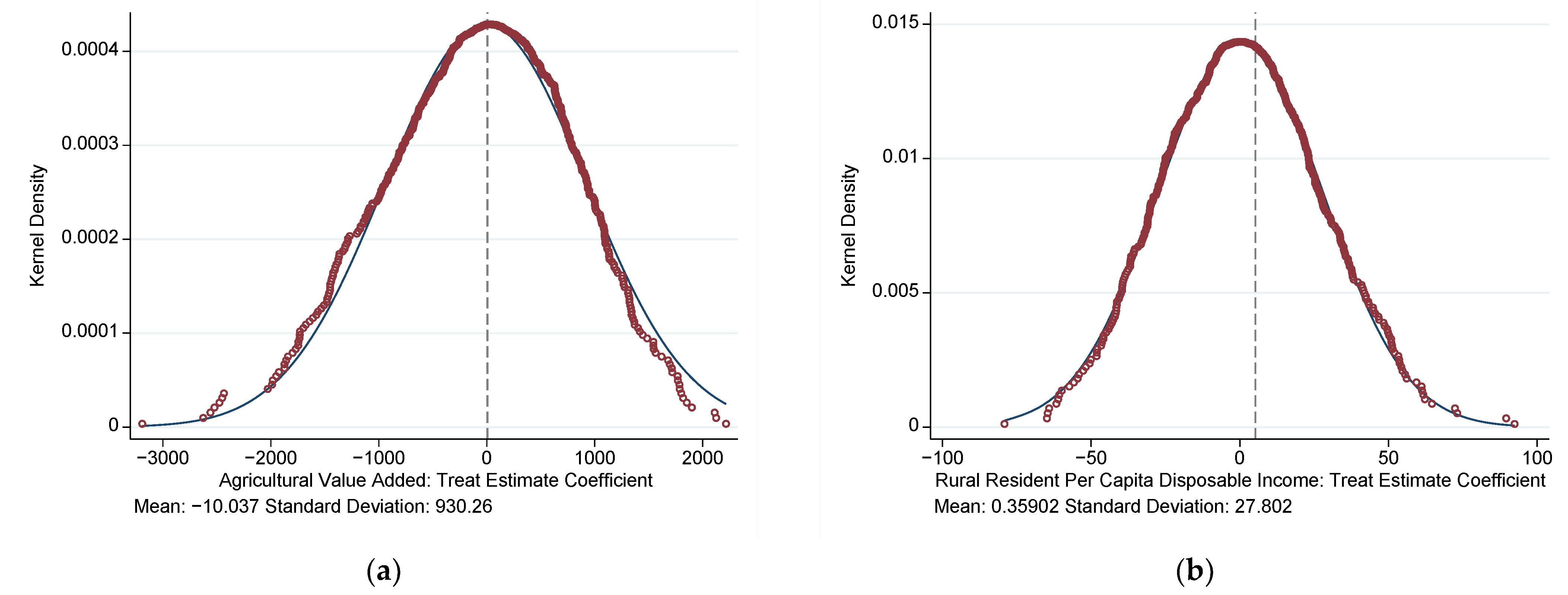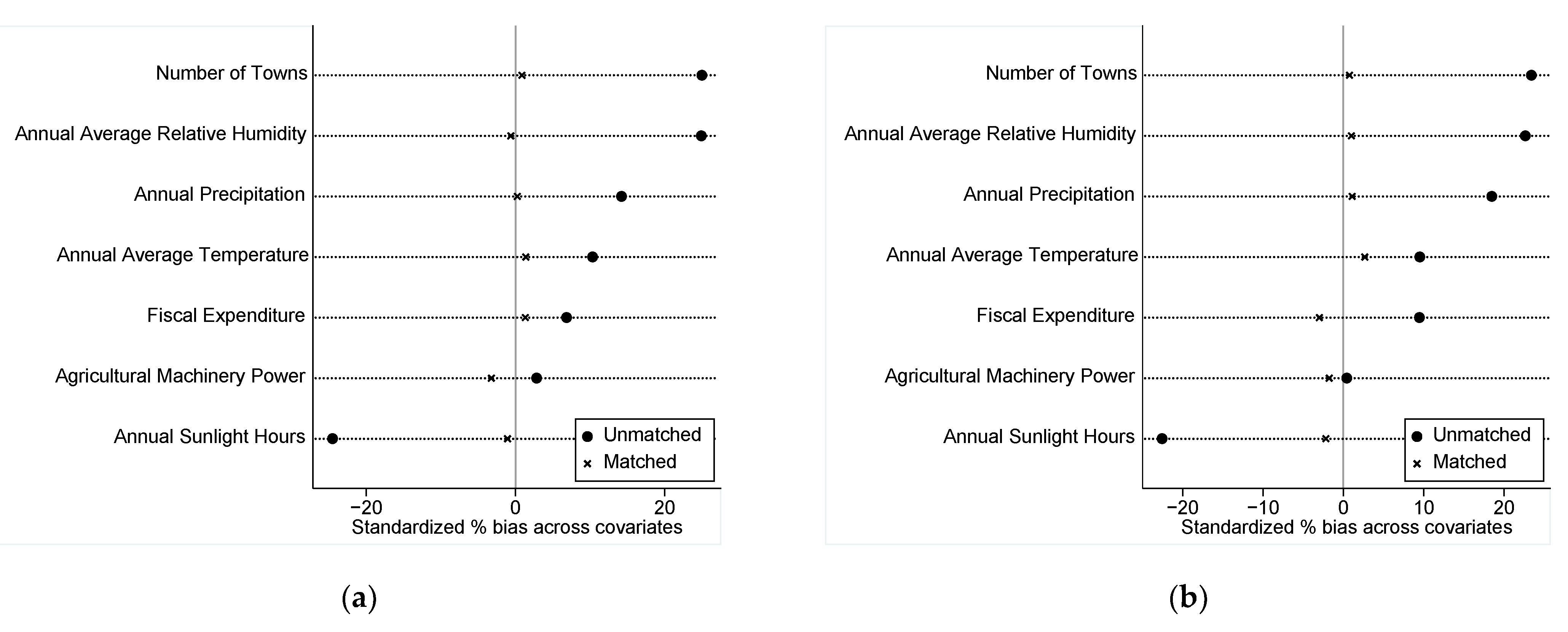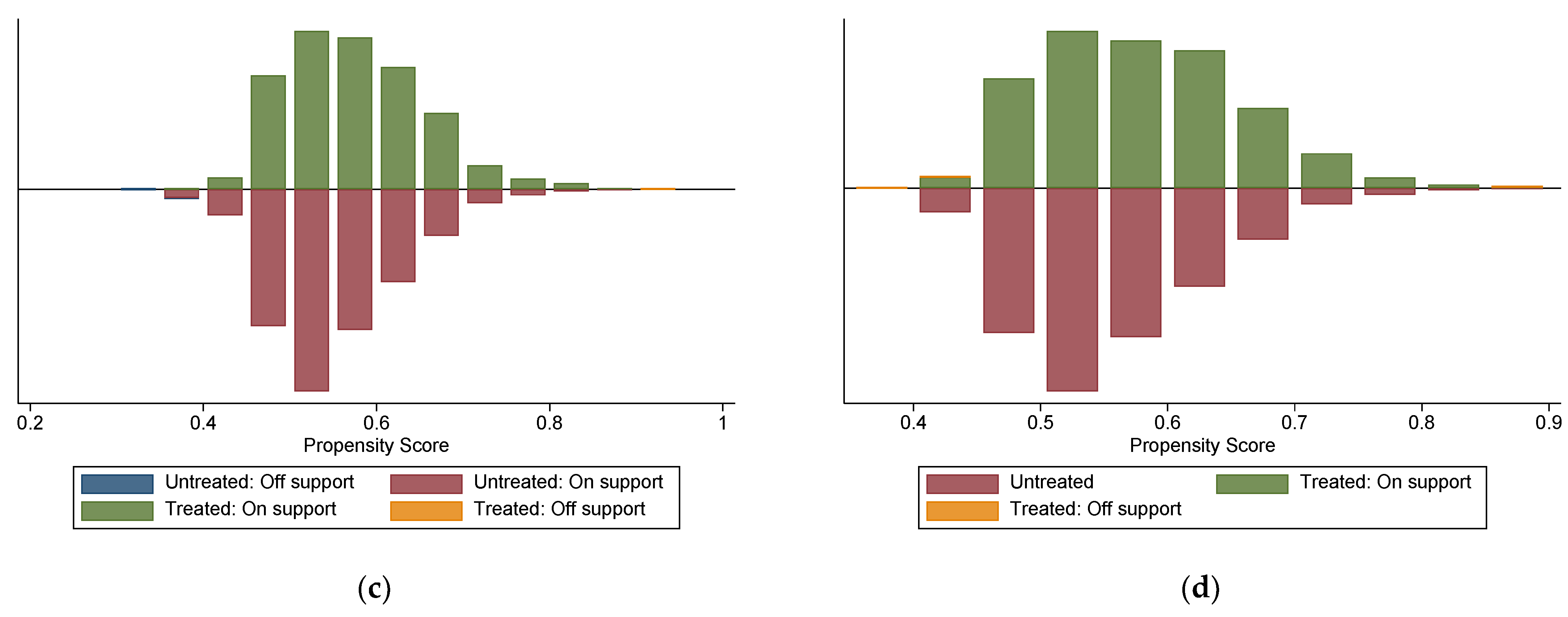1. Introduction
According to the definition by the World Intellectual Property Organization (WIPO), geographical indications (GIs) are signs used on products that have a specific geographical origin and possess qualities, reputation, or other characteristics that are essentially attributable to that place of origin. They differentiate products based on local natural factors and traditional production methods. Agricultural income is highly dependent on natural conditions which restrict productivity. Commodity crops face inelastic demand and prices, leaving farmers as price takers rather than price setters. The perishable nature of many agricultural goods also weakens farmers’ bargaining positions versus distributors and collectors. However, geographical indications for regional agricultural products can help address these problems by increasing product differentiation and added value. This allows farmers to obtain price premiums on the market, directly boosting income. Successful geographical indications also stimulate local tourism and infrastructure improvement.
According to the UN Food and Agriculture Organization’s 2014 report on GIs: “Adding Value to Agricultural Products, the market share of Cognac brandy was only 1% of global brandy sales in 1960, but exceeded 50% by 2014”. In another report from the French Ministry of Agriculture in 2014, it is estimated that the production and sales of Roquefort blue cheese could help generate around 500 formal job positions in the Aveyron region. In economics, GIs are considered to promote rural development mainly through two mechanisms—reducing information asymmetry and enabling a degree of monopoly power for producers.
Information asymmetry has been extensively studied as a source of market failure in the seminal work by Akerlof [
1] on quality uncertainty and adverse selection. This problem is salient in agricultural markets, where intermediaries and distributors understand product attributes better than consumers. Without full information, low-quality goods can crowd out high-quality ones if buyers are unable to differentiate them. Geographical indications have been analyzed as a policy tool to mitigate such inefficiencies. By providing official quality certification based on geographical origin, GIs help convey reliable signals to reduce information gaps between producers and consumers [
2,
3].
On the other hand, agricultural producers often face high buyer power which depresses their pricing premiums [
4]. This results in lower added value, especially in countries where international trade of farm products is relatively restricted [
5]. Direct government subsidies have limited effects on addressing this issue and may negatively impact farm survival [
6]. GIs as a special form of intellectual property rights confer a degree of monopoly based on geographical origin and product qualities. This increases bargaining power and product added value for farmers [
7,
8,
9], thereby promoting agricultural growth and income in rural regions. While some argue such monopoly effects of GIs may disrupt market competition [
10], they can be viewed as correcting inefficiencies caused by information gaps from a welfare economics perspective [
3,
8,
11,
12,
13]. Furthermore, GIs also increase consumer willingness to pay for certified products [
14,
15,
16], though not always in a Pareto-improving manner [
3].
The existing literature on the impacts of GIs in rural areas has focused primarily on several aspects, including agricultural product prices [
17,
18,
19,
20], technical efficiency [
21,
22,
23], scale efficiency [
24], and agricultural income [
25,
26,
27]. As for impacts on smallholder farmers, Tregear et al. [
19] found that GIs can enhance the bargaining power and income distribution of smallholder farmers in global value chains. After GI registration, the planting area and yield per unit area of onions increased, while onion prices rose, resulting in higher farmer incomes. Zhang et al. [
27] examined how GIs help reduce urban–rural income disparities from the perspective of agricultural exports. The main mechanisms were increasing value-added products and promoting agricultural structural upgrading in less developed regions.
From a regional perspective, the existing literature has extensively discussed the impacts of GIs on rural development [
28,
29,
30,
31,
32,
33]. As a relatively mature example of geographical indications, most studies have examined the effects of European GIs on agricultural producers [
34,
35,
36,
37]. For instance, in Greece, geographical indications can potentially influence value-added products and scarcity through the localization of production, thereby raising farmer income [
35]. Kizos et al. [
37] analyzed six case studies in Austria, Italy, Greece, and Japan, highlighting the important role of GIs in sharing agricultural information and emphasizing that it should be a process rather than a single step. Some studies have also explored the role of GIs in agricultural development in non-European countries [
9,
32,
33,
38,
39]. For example, research by Neilson et al. [
32] suggests limited impacts of GIs on Indonesia’s coffee farming industry. Similarly, the study by Bowen and Zapata [
33] indicates the negative effects of the tequila industry on local economies, owing to the disregard for geographical indications. From the existing literature, it appears that GI systems do not achieve expected outcomes in all countries. As stated, most developing countries “do not have sufficient experience to apply GIs” [
40]. Moreover, challenges like limited market differentiation, missing complementary investments, and inadequate legal systems constrain the effectiveness of GIs for inclusive rural development in low-income countries [
41].
Among studies related to China, many rely on micro-level survey data to examine GIs’ effects on agricultural growth [
42,
43,
44]. For instance, Deng et al. [
42] surveyed producers in Zhejiang and Fujian and found that GIs helped enhance international competitiveness of agricultural products. Zhan and Yu [
44] analyzed survey data from 437 households and identified significant impacts of GIs on farmers’ economic benefits. Xue and Yao [
43] studied citrus-planting farmers and concluded that GIs promoted agricultural input use and technology adoption.
A summary of relevant references related to this paper is presented in
Table 1.
While existing studies have discussed how GIs benefit rural development from multiple angles, some research gaps remain to be explored. First, most works in the literature rely on case studies or small-scale sample surveys, lacking large-scale quantitative empirical evidence. Second, due to data limitations, current research tends to utilize case analyses or micro-level surveys, making it difficult to causally evaluate the treatment effects of GIs on rural development. Finally, existing literature exploring the impact of GIs on rural development in non-European countries remains an area that could benefit from further enrichment. Investigating the influence of GI systems in countries with substantial agricultural populations, such as China and India [
45,
46], holds positive significance in addressing global poverty challenges.
This study evaluates the impacts of GI registration on rural economic development from the perspectives of agricultural growth and farmer income. Using GI approval data from China’s Ministry of Agriculture and Rural Affairs and county-level economic data from 2010 to 2019, the analysis assesses how GIs promote regional agricultural production and contribute to rural development. To ensure robustness of the effect estimates, causal identification strategies and machine learning techniques are utilized to address endogeneity concerns. The study further investigates heterogeneous effects of GIs across different product categories, offering insights into the optimal targeting of GI policies.
Compared to the existing literature, this study makes several potential contributions. First, it reveals the positive impacts of China’s GI system on both agricultural growth and farmer income using a comprehensive national-level dataset. Most prior studies rely on small-scale surveys of individual GI products, lacking generalizability [
25,
43,
44]. By leveraging macro-level data across counties and years, this research provides more representative evidence on how GI policies reshape regional agricultural development under real-world conditions. The findings can inform national policymaking on scaling up and optimizing China’s GI system.
Second, this study investigates the heterogeneous treatment effects of different types of GIs, including products with different categories of agri-food products. The existing literature rarely compares the development impacts of GIs across products, representing a significant research gap [
47,
48]. The product-specific estimates generated in this study reveal how GI effectiveness varies based on product attributes. The results provide insights into prioritizing GI development policies by product category to maximize rural income growth.
Third, this research contributes to the existing literature on geographical indications (GIs) in China. As a representative country in East Asia, China exemplifies a variety of agriculture-dependent nations. In contrast to several studies on GIs and rural development in European countries [
7,
30], this research addresses a knowledge gap by quantifying the impact of GIs on agricultural and income growth in rural China. Given China’s prominence as a major GI producer, the findings provide valuable insights for policymaking, offering guidance on how to leverage GIs and intellectual property tools to foster inclusive development in countries like China.
The remaining content of this paper is structured as follows:
Section 2 provides an introduction to the background, data, methods, and design of the research.
Section 3 reports the results of empirical tests, including baseline regression and causal inference, robustness checks using machine learning, and further analysis based on the classification of geographical types.
Section 4 summarizes the conclusions of the study and initiates discussions, along with offering policy recommendations.
2. Materials and Methods
2.1. Research Background and Hypotheses
Geographical indications (GIs) were first legally protected in China in the 1990s. With China’s accession to the WTO in 2001, the legislation and approval of GIs accelerated. The State Administration for Industry and Commerce, the General Administration of Quality Supervision, Inspection and Quarantine, and the Ministry of Agriculture are the main governmental agencies that formulated regulations and granted GI certification. While progress was slow before 2005, the number of approved GIs grew rapidly afterward, exceeding 1000 by 2012. Promoting GIs has since been an important aspect of China’s rural revitalization policies. As of today, China has the most GI products globally, demonstrating the vital role of GIs in boosting regional brands and rural development.
The data on geographical indications for agricultural products used in this study were obtained from the China Green Food Center, an association affiliated with the Chinese Ministry of Agriculture. The dataset records the date of registration, product name, province, certificate holder, product type, and certificate number for each geographical indication of the agricultural products. Unlike the geographical indications for processed products published by the Intellectual Property Office, all of the GI products included in this dataset are unprocessed primary agricultural goods.
Table 2 summarizes the number of new GIs granted annually during this period across product categories. Fruit, cereal crops, and vegetables and edible fungi have the most certified GIs. The annual number of new GIs fluctuated, with rapid growth before 2010 and some volatility in the years after. By 2021, the total number of agricultural GIs reached 3430.
Theoretically, by protecting the reputation of agricultural products from specific regions, geographical indications can endow products with brand value and recognition. This allows producers to charge premium prices and stimulates market demand, thereby increasing agricultural added value and farmers’ income in corresponding regions.
To examine whether this mechanism is empirically observable at the national level, we visualized the aggregate relationships using scatter plots.
Figure 1a,b depict the cumulative numbers of agricultural GIs versus China’s agricultural added value and rural per capita disposable income during 2008–2021.The scatterplot shapes indicate a strong positive correlation between the cumulative number of GIs obtained and each respective indicator, with the data points forming an approximate linear relationship: regions with higher total acquired GIs tended to have greater agricultural added value and rural income growth at the national level, as evidenced by the close to linear trend lines. Therefore, we further contemplate whether this relationship is generally prevalent at a more detailed level, forming the starting point for the research questions addressed in this paper.
2.2. Data Sources
This study utilizes data from multiple sources. The data on agricultural GIs were obtained from the public reports of approved GIs published by the Chinese Ministry of Agriculture (MOA). Specifically, the Green Food Association, affiliated with MOA, releases on its official website the registration information for all agricultural GIs in China, including the GI name, authorized unit, and product category. In this paper, the original data was preprocessed using Python 3.7 and the models were built and analyzed using STATA 16.0.
The outcome variables of agricultural added value and rural disposable income per capita are from the China County Statistical Yearbooks. Control variables related to geographic, climate, fiscal, industrial, and agricultural conditions also come from the yearbooks.
To alleviate endogeneity concerns, alternative data are used to construct instrumental variables. The provincial cumulative GI numbers are calculated based on the Intellectual Property Office’s approval announcements. The average cumulative GI counts of neighboring counties are derived from the geospatial relationships between counties.
By matching the GI data with the statistical yearbooks, a comprehensive county-level panel dataset is compiled for the empirical analysis. The sample covers 1731 counties from 2000 to 2019. Several validation checks are conducted to recheck the accuracy of data from the local government annual reports, ensuring the accuracy and consistency of the combined data from multiple sources.
The use of authoritative statistical yearbooks provides reliable county-specific observations. The panel structure enables controlling unobserved heterogeneity. The expansive coverage offers significant variations across regions and GI categories for identification. Data processing and integration are conducted carefully to guarantee data quality for rigorous empirical examination.
2.3. Model Specification
The central inquiry of this study revolves around assessing the impact of cumulative acquisitions of GIs on agricultural growth and rural income. To effectively tackle this multifaceted question, we employ a panel-fixed-effects model. This approach is particularly advantageous as it helps control for unobservable time-invariant factors that could confound the relationship between GIs and agricultural outcomes. By doing so, it allows us to isolate the treatment effect of GIs more effectively. The specific model is as follows:
In the equation, represents the outcome variable, which corresponds to either the agricultural added value or the per capita disposable income of rural areas in each county or district. is the intercept; represents the cumulative acquisition of GIs for agricultural products; is the estimated coefficient for the treatment effect; is the set of control variables with as the vector of their estimated coefficients. Although this study attempts to control for the set of variables that may simultaneously affect the dependent variable and the core explanatory variable, it is challenging to entirely eliminate endogeneity issues resulting from omitted variables. To address this, the study controls for individual fixed-effects at the county or district level to account for individual factors that do not change over time, and time-fixed-effects to control for time-related factors that do not vary across individuals. represents the random error term in the model.
Furthermore, recognizing that GI acquisitions constitute events with lasting consequences and are influenced by relatively exogenous factors such as county-level natural environments, historical contexts, and cultural influences, we also employ the difference-in-differences (DID) method in robustness parts. DID offers several distinct advantages. It provides a framework to identify causal relationships by comparing changes in outcomes between the treatment group (counties acquiring GIs) and control group (those not acquiring GIs) over time. It can also account for potential time-varying confounding factors. This DID approach can strengthen causal inference and provide insights into the long-term effects of GIs. The specific model for identifying the treatment effect is as follows:
Unlike Equation (1), in Equation (2), the core explanatory variable is replaced with a DID term (as above) representing the cumulative acquisition of GIs by counties or districts. In other words, if a county or district has ever acquired a GI in any year, then takes the value of 1, otherwise it takes the value of 0; is the dummy variable representing whether a county or district gained any GI in year t, since the value will take 1 from that year onward. Control variables are added to the treatment effect identification model to ensure that the model satisfies the parallel trends assumption. Additionally, individual and time fixed effects are controlled to mitigate the impact of omitted variable bias.
However, it is important to acknowledge the limitations of DID, particularly when dealing with multiple time points and potential non-linearity in the treatment effect. To address these limitations and further enhance the precision of our estimations, we leverage the double/debiased machine learning (DML) approach. The DML method, as proposed by Chernozhukov et al. [
49], leverages the advantages of machine learning models in high-dimensional data to control confounding factors’ interference with treatment effects [
6]. This results in more unbiased estimates, reduced estimation variance, increased estimation accuracy, and greater flexibility in relaxing the linear treatment effect assumption of the model. By doing so, DML provides more unbiased estimates, reduces estimation variance, and offers greater flexibility in modeling the treatment effect, thereby allowing us to capture nuanced relationships between GIs and agricultural growth as well as income levels in rural areas.
To elucidate its fundamental principles, the DML method utilizes the example of the partially linear model as follows:
In the above equations, after controlling for confounding covariate set , whose functional form does not necessarily have to be linear, represents the estimated coefficient for the treatment variable , which is the main estimation objective of this method. denotes the conditional expectation of the treatment effect given the covariate set, i.e., . and are both random error terms. Specifically, DML divides the dataset into two parts: one for estimating interference terms and the other for estimating treatment effects and structural parameters. Modern machine learning methods, such as random forests, are used to estimate interference terms, including and . Subsequently, the estimated interference terms are used to eliminate estimation bias for treatment effects and structural parameters. Finally, semi-parametric methods like local linear regression or kernel regression are employed to estimate treatment effects and structural parameters. Compared to traditional statistical methods, DML offers the advantages of relaxing the linearity assumption of the DID model, the parallel trends assumption, and provides more unbiased and efficient estimates.
2.4. Variable Selection
The key explanatory variable is the cumulative number of agricultural GIs at the county level, which measures the total GIs obtained in each county by each year. The outcome variables are the annual agricultural added value and rural per capita disposable income for each county.
The core explanatory variable is the cumulative number of agricultural GIs at the county level in China during 2000–2019. The dataset only provides information on the province for each GI product, without specifying the district or county. In order to match the GI information to the district and county levels, we use text analysis to extract the geographical information from the product name and certificate holder name. We then query the corresponding 6-digit administrative code to use as the identifier. The panel data of cumulative GI counts and approval years are constructed for each county.
To account for confounding factors, control variables that may affect both GI adoption and outcomes are included in the regressions. Natural conditions like temperature, humidity, and precipitation determine the types of agriculture and thus may influence GI application and productivity. Agricultural machinery power reflects infrastructure conditions. Fiscal expenditures and the number of towns/villages represent government institutional factors. These controls are relatively stable and unlikely to be influenced by reverse causality.
The machine learning methods in this study incorporate a comprehensive set of covariates, including major indicators from the China County Statistical Yearbooks that can potentially affect both GI adoption and outcomes. On one hand, the high-dimensional covariate space allows machine learning models like random forests to partition the feature space in more dimensions, better isolate the effects of GIs, and reduce omitted variable bias. This flexibility relaxes the strict exogeneity assumptions in linear models. On the other hand, high dimensionality risks overfitting a particular dataset. To address this, ensemble approaches are used to aggregate predictions from different decision trees and improve out-of-sample prediction. Cross-validation further enhances generalizability by evaluating performance on held-out subsets.
Summary statistics of the main variables are presented in
Table 3. The sample covers 1731 counties from 2000 to 2019, with over 20,000 observations. There is substantial variation in GIs obtained across counties and over time during the sample period.
4. Conclusions and Discussion
As an important factor influencing the supply and demand of agricultural products, the geographical indication system also plays a vital role in rural development and is of great significance with regard to policies in raising farmer incomes, boosting agricultural added value, and maintaining stability in agricultural supply chains. By leveraging nationally representative county-level data and rigorous econometric approaches, this study helps bridge the knowledge gap and demonstrates the substantial impact of GIs on promoting agricultural and rural growth in China. Synthesizing the analysis conducted in this paper, several meaningful conclusions can be drawn.
Firstly, the results of this study illustrate a noteworthy effect—the acquisition of GIs for agricultural products significantly enhances the per capita disposable income of farmers. On average, every additional geographical indication acquired in China’s counties and districts boosts agricultural added value by CNY 58.97 million, which translates to an increase of CNY 162 per capita disposable income for local farm households. This finding is consistent with the research conducted by Zhang et al. [
27], which also suggests that securing GIs can mitigate the income disparities between urban and rural areas, representing an alternative facet of bolstering farmers’ income. Nevertheless, it is essential to note a divergence between this study and Zhang et al.’s [
27] research. While Zhang et al. employed provincial-level data, our study employs county-level data, offering a finer level of granularity. This finer resolution permits a more accurate identification of treatment effects, thus better mitigating the potential influence of economic fluctuations and non-agricultural factors on the observed treatment effects.
Secondly, treating access to GIs as an exogenous shock and estimating the results after GI access relative to without or before access shows that this treatment effect boosts agricultural output by CNY 106.43 million and per capita disposable income by CNY 347, respectively. The estimates from matching similar counties and districts as a control group based on natural conditions and the size of economy are also closer in value. Using the DML-DID method, the estimates become substantially higher when random forest estimation replaces linear regression to mitigate endogeneity from omitted variables. The DML-DID models estimate that agricultural output increases by CNY 142.76 million and per capita disposable income rises by CNY 581. This suggests that the impact of GIs on rural development is relatively robust. Given the limited set of covariates, the true uplift from GIs may be even greater than estimated in this paper.
Thirdly, this study conducts a cross-category comparison of different types of GIs to uncover their heterogeneous treatment effects on agricultural added value and per capita income in area. The results reveal noticeable variations in the economic impacts across GI categories. For instance, the acquisition of GIs for vegetables and fungi, fruits, aquatic products, dairy, cotton, and tobacco demonstrates the most pronounced positive effects on agricultural productivity. In contrast, obtaining geographical indications for highly processed crops such as sugar and tea has negative effects on agricultural added value but increases farmers’ income. The possible reason is that such geographical indications enhance the added value of these products, specifically the prices of raw materials. Traditional farmers, who were originally reliant on local enterprises for cooperative production, are now more inclined to invest in processing production due to the price changes brought about by geographical indications. This signifies an increase in vertical integration, aligning with the findings of [
31]. The rise in prices of raw material products leads to an increase in production costs, which is one of the potential reasons for the decrease in agricultural added value. However, from the perspective of increased farmer income, this is not considered a negative impact. Overall, these findings provide strong evidence on the necessity of developing tailored policies based on the unique characteristics and industrial contexts of different GI products, which are consistent with [
51].
While this study provides novel evidence on the positive effects of GIs using rigorous methods, it has some limitations that could be addressed in future research. First, due to data limitations, we are unable to precisely identify the contribution of each GI category to agricultural output. This means the estimates in this paper may still face some confounding from unobserved factors. Second, due to the relatively small number of GI infringement cases in China, which totaled only four nationwide as of August 2023, we are unable to assess the impact of government efforts to protect GIs on rural development. Third, dynamic and lagged effects of GIs deserve further investigation with time-series techniques. Lastly, other factors like cultural effects and promotional efforts may also play a role.
Despite these limitations, this study offers several meaningful policy implications. First, the regulatory oversight and promotion for strategic GI products with significant agricultural returns should be strengthened, such as vegetables, fruits, and aquatic products. Second, misallocation issues in certain processed crop GIs need to be addressed to realize their potential. Third, balancing the interests across all stages of the industry value chain is essential, especially for processed products. Fourth, standardized benefit sharing and enforcement mechanisms for different GI categories can be considered. Fifth, localized GI development plans should be formulated based on regional contexts and strengths. Ultimately, this study provides strong empirical support for optimizing China’s GI system and policies to drive sustainable rural development.
